Lachlan Macquarie
| Major-General Lachlan Macquarie CB | |
|---|---|
 | |
| 5th Governor of New South Wales | |
|
In office 1 January 1810 – 30 November 1821 | |
| Preceded by | William Bligh |
| Succeeded by | Thomas Brisbane |
| Personal details | |
| Born |
31 January 1762 Ulva, Inner Hebrides, Scotland |
| Died |
1 July 1824 (aged 62) London, England |
| Spouse(s) |
Jane Jarvis (m. 1792–1796) Elizabeth Campbell (1807–1835) |
| Military service | |
| Battles/wars | Australian Frontier Wars |
Major-General Lachlan Macquarie CB (/məˈkwɒrɪ/; Scottish Gaelic: Lachann MacGuaire; 31 January 1762 – 1 July 1824)[1] was a British Army officer and colonial administrator from Scotland. He served as the fifth and last autocratic Governor of New South Wales from 1810 to 1821,[2] and had a leading role in the social, economic and architectural development of the colony. He is considered by historians to have had a crucial influence on the transition of New South Wales from a penal colony to a free settlement and therefore to have played a major role in the shaping of Australian society in the early nineteenth century.[3][4] An inscription on his tomb in Scotland describes him as "The Father of Australia".[5]
Early life and career
Lachlan Macquarie was born on the island of Ulva off the coast of the Isle of Mull in the Inner Hebrides, a chain of islands off the West Coast of Scotland. He was a gentleman of the Scottish Highland family clan MacQuarrie which possessed Ulva, Staffa, and a region of the Isle of Mull for over one thousand years, and his forebears were buried on Iona. Governor Macquarie's father, a "man of Intelligence, polite, and much of the world", supposedly attained the age of 103 years, dying on 4 January 1818.[6] His mother was the daughter of a Maclaine chieftain who owned a castle on the Isle of Mull.[7] Macquarie left the island at the age of 14.[8] If he did attend the Royal High School of Edinburgh, "as tradition has it",[9] it was only for a very brief period because, at the same age, he volunteered for the army.[10]
Macquarie joined the 84th Regiment of Foot on 9 April 1777, travelling with it to North America in 1777 to take part in the American War of Independence. As a new recruit on the way to America he participated in the Battle of the Newcastle Jane. This battle was the first naval victory for a British merchant ship over an American privateer. He was initially stationed at Halifax, Nova Scotia, and was commissioned as an ensign five months after his arrival. On 18 January 1781, he was promoted to lieutenant and transferred to the 71st (Highland) Regiment of Foot, and served with them in New York City, Charleston, and Jamaica.[10] In June 1784 he returned to Scotland as a half-pay lieutenant.[10] Three years later, on Christmas Day 1787 he received his commission as lieutenant in the 77th Regiment, where he saw service with the army in India and Egypt. Macquarie became a Freemason in January 1793 at Bombay, in Lodge No. 1 (No. 139 on the register of the English "Moderns" Grand Lodge).[11] He was promoted Captain on 9 November 1789, Major on 12 March 1801. During 1801 he had accompanied Sir David Baird and the Indian Army to Egypt, with the rank of Deputy Adjutant General, and was present at the capture of Alexandria and the final expulsion of the French Army from Egypt. Two years later, 1803, he was in London, as Assistant Adjutant General to Lord Harrington, who commanded the London district. In 1803 and 1804 saw him on active service in India. He returned to London in 1807, commanding the 73rd Regiment of Foot, and on 8 May was appointed Governor of New South Wales and its dependencies, leaving for the colony on 22 May 1809, in HMS Dromedary, where he landed officially on 31 December 1809, at Sydney Cove.[6]
In 1793 he married Jane Jarvis, daughter of the Chief Justice of Antigua. Three years later she died of tuberculosis.[12]
Governor of New South Wales

In November 1807, Macquarie's cousin Elizabeth Henrietta Campbell became his second wife. In April 1809 Macquarie was appointed Governor of New South Wales. In making this appointment, the British government reversed its practice of appointing naval officers as governor and chose an army commander in the hope that he could secure the co-operation of the unruly New South Wales Corps,[13] and aided by the fact he arrived in New South Wales at the head of his own military unit, the 73rd Regiment. At the head of regular troops he was unchallenged by the New South Wales Corps whose members had become settled in farming, commerce and trade.[14]
Macquarie was promoted to Colonel in 1810, Brigadier in 1811 and Major-General in 1813, while serving as governor.
The Macquaries departed from England in May 1809 aboard HMS Dromedary, accompanied by HMS Hindostan. They reached Sydney on 28 December 1809. He started as a governor on 1 January 1810 and he appointed John Campbell as his secretary.[15]
The first task Macquarie had to tackle was to restore orderly, lawful government and discipline in the colony following the Rum Rebellion of 1808 against Governor William Bligh. Macquarie was ordered by the British government to arrest both John Macarthur and Major George Johnston, two of the leaders of the Rum Rebellion. However, by the time Macquarie arrived in Sydney in December 1809, both Macarthur and Johnston had already sailed for England to defend themselves.[16] Macquarie immediately set about cancelling the various initiatives taken by the rebel government—for example, all "pardons, leases and land grants" made by the rebels were revoked, (although many were later re-issued).[16]
Although with the arrival of Lachlan Macquarie, the New South Wales Corps and its monopoly were ended, the military influence survived, with military officers having sway over the justice system. A great gulf existed between the officers and their factional division which included the free settlers ("exclusives") and convicts who had completed their term of imprisonment and were now settlers ("emancipists").
New South Wales suffered severe drought in 1812 and 1813, there was widespread loss of crops and livestock and by 1814 many farmers were close to insolvency because of the drought and ensuing depression.
In 1814 a Second Charter of Justice was issued for New South Wales. It defined how the civil court system was to be structured. Three new Courts of Civil Judicature were to be established in New South Wales: the Governor's Court, the Lieutenant-Governor's Court and the Supreme Court. Jeffrey Hart Bent, the brother of the Judge Advocate, arrived in the colony as the first judge of the new Supreme Court.
Courts need lawyers and Macquarie's efforts to allow emancipist attorneys to appear before the Supreme Court was blocked by Jeffrey Bent, who, with his brother, had his allegiances with the military and exclusive settlers. Later in 1814, two solicitors, Fredrick Garling and Moore, arrived in New South Wales. English law was to be followed as far as it was possible. Where new ordinances or laws were needed, they were to be consistent with English laws as far as the particular circumstances of the colony would allow. Many of the settlers were discontented with this, because they questioned whether some of the governors' ordinances were, in fact, valid. Claims were made in New South Wales and in England that governors were exceeding their authority by making ordinances that were in conflict with English laws.
Macquarie's relationship with the new Court was never harmonious. The brothers Bent, in their key legal positions, quickly became opponents of the Governor, and personal antipathy affected decisions on both sides. Like most of the governors before him, Macquarie's noble ideals were undermined by harsh realities and constant opposition. In 1816 he enforced his new proclamation against trespassing on the Government Domain by having three trespassers (all free settlers) flogged. This incident was one of several of which Bent and others complained to the British Government as examples of Macquarie's authoritarian excesses. As a result, Macquarie was censured by Lord Bathurst, the Secretary of State for Colonies, and in 1819 Commissioner John Thomas Bigge was sent to enquire into affairs in New South Wales.
Macquarie took control of the colony, breaking the power of the Army officers such as John Macarthur, who had been the colony's de facto ruler since Bligh's overthrow.[17] He was "the last British proconsul sent to run New South Wales as a military autocracy".[18]
In 1812, the first detailed inquiry into the convict system in Australia by a Select Committee on Transportation, supported in general Macquarie's liberal policies.[19] However, the committee thought that fewer tickets of leave should be issued and opposed the governor having the power to grant pardons. The committee concluded that the colony should be made as prosperous as possible so as to provide work for the convicts and to encourage them to become settlers after being given their freedom.[20]
On a visit of inspection to the settlement of Hobart Town on the Derwent River in Van Diemen's Land (now Tasmania) in November 1811, Macquarie was appalled at the ramshackle arrangement of the town and ordered the government surveyor James Meehan to survey a regular street layout. This survey determined the form of the current centre of the city of Hobart.[21]
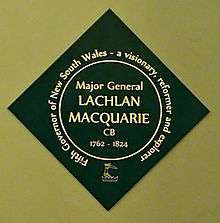
Macquarie is credited with producing the first official currency specifically for circulation in Australia. Foreign coins were common in the early years of the New South Wales colony but much of this coin left the colony as a result of trade with visiting merchant ships. To secure a reliable supply of coins, in 1812 Macquarie purchased 40,000 Spanish dollar coins and had a convicted forger named William Henshall cut the centres out of the coins and counter stamp them to distinguish them as belonging to the colony of New South Wales and prevent them being useful elsewhere. The central plug (known as a "dump") was valued at 15 pence and the rim (known as a holey dollar) became a five-shilling piece.[22] The new currency was proclaimed in the Sydney Gazette of 10 July 1813, with offences of forgery, utterance or exportation of the new currency being punishable by seven years in the Newcastle coal mines.[23]
The end of the Napoleonic Wars in 1815 brought a renewed flood of both convicts and settlers to New South Wales, as the sea lanes became free and as the rate of unemployment and crime in Britain rose.[24] Macquarie presided over a rapid increase in population and economic activity. By the time of his departure for London on 15 February 1822,[25] the white population had reached an 'estimated' 36,969.[26]
As reformer and explorer
Central to Macquarie's policy was his treatment of the emancipists: convicts whose sentences had expired or who had been given conditional or absolute pardons. By 1810 emancipists had outnumbered the free settlers, and Macquarie set the tone himself by appointing emancipists to government positions: Francis Greenway as colonial architect[27] and Dr William Redfern as colonial surgeon.[28] He scandalised settler opinion by appointing an emancipist, Andrew Thompson, as a magistrate,[29] and by inviting emancipists to tea at Government House. In exchange, Macquarie demanded that the ex-convicts live reformed (Christian) lives. He required that former convicts regularly attend church services, and in particular, strongly encouraged formal Christian (Anglican) marriages.[30]
Macquarie was the greatest sponsor of exploration the colony had yet seen. In 1813 he authorised Blaxland, Wentworth and Lawson's successful crossing of the Blue Mountains where they found the great plains of the interior.[31][32] There he ordered the establishment of Bathurst, Australia's first inland city. He appointed John Oxley as surveyor-general and sent him on expeditions up the coast of New South Wales and inland to find new rivers and new lands for settlement. Oxley discovered the rich Northern Rivers and New England regions of New South Wales, and in what is now Queensland he explored the present site of Brisbane.
The street layout of modern central Sydney is based upon a street plan established by Macquarie.[27] The colony's most prestigious buildings were built on Macquarie Street. Some of these still stand today. What has survived of the Georgian 'Rum Hospital' serves as the Parliament House of the state of New South Wales.[27] It is probable that the hospital was designed by Macquarie himself, in collaboration with his wife. The building's wide verandas were evidently inspired by Macquarie's familiarity with English colonial architecture in India.[33] The elaborate stables which Macquarie commissioned for Government House are part of the modern structure housing the Sydney Conservatorium of Music.[34] Both of these buildings were constructed by Macquarie in defiance of the British government's ban on expensive public building projects in the colony[33] and reflect the tension between Macquarie's vision of Sydney as a Georgian city and the British government's view of the colony as a dumping ground for convicts to be financed as cheaply as possible.
Another fundamental reform initiated by Macquarie of enduring significance was made on 15 August 1820, shortly before his return to England, when he ordered all traffic on New South Wales roads to keep to the left.[35]
The origin of the name "Australia" is closely associated with Macquarie. "Australia", as a name for the country which we now know by that name, was suggested by Matthew Flinders, but first used in an official despatch by Macquarie in 1817.[36]
Macquarie's policies, especially his championing of the emancipists and the lavish expenditure of government money on public works, aroused opposition both in the colony and in London, where the government still saw New South Wales as fundamentally a penal colony. His statement, in a letter to the Colonial Secretary, that "free settlers in general... are by far the most discontented persons in the country" and that "emancipated convicts, or persons become free by servitude, made in many instances the best description of settlers", was much held against him.
Despite opposition from the British government, Macquarie encouraged the creation of the colony's first bank, the Bank of New South Wales, in 1817.[37]
Aboriginal-settler relations
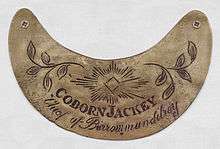
Macquarie is regarded as having been ambivalent towards the Australian Aborigines. He ordered punitive expeditions against Aboriginal people.[38] However, when dealing with friendly tribes, he developed a strategy of nominating a 'chief' to be responsible for each of the clans, identified by the wearing of a brass breast-plate engraved with his name and title. Although this was a typically European way of negotiation, it often did reflect the actual status of elders within tribes.[39] Macquarie also pioneered the concept of returning land to Aboriginal control, commencing with areas surrounding Brokne bay and Georges head.[40]
In 1814 Macquarie founded the Native Institution in Parramatta for the education of Aboriginal children. Aboriginal children were enrolled in the school, sometimes forcibly, and were brought up in accordance with European education and culture. Although the children in the School were well treated, modern social analysis indicates their forced enrolment and subsequent Europeanised social education as a conscious attempt to reduce the influence and future of indigenous culture.[41][40]
Modern historians have also identified the forced taking of children for the School as a cause of the outbreak of open conflict between the indigenous population and Governor Macquarie's administration, commencing in 1814 and continuing for at least two years.[40]
Return to Scotland, death, and legacy
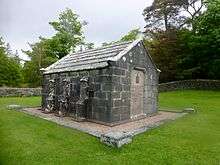
Leaders of the free settler community complained to London about Macquarie's policies, and in 1819 the government appointed an English judge, John Bigge, to visit New South Wales and report on its administration. Bigge generally agreed with the settlers' criticisms, and his reports on the colony led to Macquarie's resignation in 1821; he had, however, served longer than any other governor. Bigge also recommended that no governor should again be allowed to rule as an autocrat, and in 1824 the New South Wales Legislative Council, Australia's first legislative body, was appointed to advise the governor.[42]
Macquarie returned to Scotland, and died in London in 1824 while busy defending himself against Bigge's charges. But his reputation continued to grow after his death, especially among the emancipists and their descendants, who were the majority of the Australian population until the gold rushes. Today he is regarded by many as the most enlightened and progressive of the early governors who sought to establish Australia as a country, rather than as a prison camp.[43]
The nationalist school of Australian historians have treated him as a proto-nationalist hero. Macquarie formally adopted the name Australia for the continent, the name earlier proposed by the first circumnavigator of Australia, Matthew Flinders. As well as the many geographical features named after him in his lifetime, he is commemorated by Macquarie University in Sydney.
Macquarie was buried on the Isle of Mull in a remote mausoleum with his wife, daughter and son. His grave in Mull is maintained by the National Trust of Australia and is inscribed "The Father of Australia".[44]
Places named after Macquarie
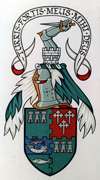
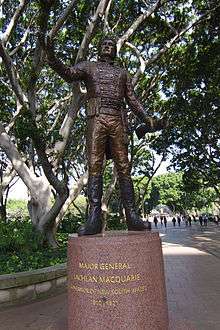
Many places in Australia have been named in Macquarie's honour (some of these were named by Macquarie himself). They include:
At the time of his governorship or shortly thereafter:
- Macquarie Island between Tasmania and Antarctica the subsequent tectonic plate Macquarie Ridge and junction which align northwards from the island are also named after Macquarie.
- Lake Macquarie on the coast of New South Wales between Sydney and Newcastle renamed after Macquarie in 1826
- Macquarie River a significant inland river in New South Wales which passes Bathurst, Wellington, Dubbo and Warren before entering the Macquarie Marshes and the Barwon River
- Mount Macquarie, highest point in the Blayney Shire at 1100 metres above sea level. For a time it was named Mount Lachlan
- Lachlan River, another significant river in New South Wales
- Port Macquarie, a city at the mouth of the Hastings River on the Mid North Coast of New South Wales
- Macquarie Pass, a route traversing the escarpment between the Illawarra district and the Southern Highlands district of New South Wales
- Macquarie Rivulet, a river 23 kilometres long which rises near Robertson, New South Wales and drains into Lake Illawarra
- Around Sydney:
- Macquarie Culvert in the Royal Botanic Gardens
- Macquarie Street, one of the principal streets of downtown Sydney, home of the New South Wales Parliament
- Macquarie Place a small park in the Sydney CBD
- Macquarie Lighthouse, Australia's first and longest operating navigational light
- The former Fort Macquarie on Bennelong Point
- Macquarie Fields, now a suburb of Sydney but named by surveyor Evans after the governor[46]
- In Tasmania:
- Macquarie Street, one of the principal streets of Hobart
- Macquarie Street, one of the principal streets of the historic town of Evandale, a town he founded in 1811
- Macquarie Harbour, on the west coast
- Macquarie River
- In New South Wales,
- Macquarie Hill, formerly known as Mount Macquarie, in Wingecarribee Shire, Southern Highlands, New South Wales
- Macquarie Pier, built in 1818 on the Hunter River for the port of Newcastle, a breakwater linking Coal Island, now known as Nobby's Head, to the mainland at South Head (now Fort Scratchley)
- The Macquarie Arms Hotel at Windsor, New South Wales built in 1815. It ceased operating in 1840, but reopened in 1874 and has been used continuously as a hotel ever since. Windsor also contains a Macquarie Street.
- Lachlan Macquarie Ward, Parramatta, New South Wales
Many years after his governorship:
- Macquarie Park and Macquarie Links, suburbs of Sydney.
- Macquarie Shopping Centre, North Ryde
- Macquarie, a suburb of Canberra, Australia
- Lachlan Street, Macquarie, Canberra, Australia
- Division of Macquarie, one of the first 75 Divisions of the Australian House of Representatives created for the Australian Parliament in 1901.
Institutions named after Macquarie:
- Macquarie Hospital, Sydney
- Macquarie University, Sydney
- Macquarie Bank, an investment bank founded in 1970
- Macquarie Community College, an adult community education provider in northwest and western Sydney
- Lachlan Macquarie Chambers, the largest and oldest barristers' chambers in Parramatta.
Notes
- ↑ McLachlan, N. D. (1967). "Macquarie, Lachlan (1762–1824)". Australian Dictionary of Biography. Canberra: Australian National University. Retrieved 7 June 2009.
- ↑ Davidson G., et al (1998), p. 405
- ↑ Ward, R., (1975), pp. 37–38
- ↑ Molony, J., (1987), p. 47
- ↑ Davidson G., et al (1998), p. 406
- 1 2 "GOVERNOR MACQUARIE.". The Sydney Morning Herald. National Library of Australia. 1 March 1913. p. 7. Retrieved 12 November 2012.
- ↑ Ellis, M.H., (1952), p. 2
- ↑ Keay, J. & Keay, J. (1994) Collins Encyclopaedia of Scotland London. HarperCollins.
- ↑ McLachlan, N. D. (1967). Australian Dictionary of Biography: Macquarie, Lachlan (1762–1824). A020162b.
- 1 2 3 Ellis, M.H., (1952), p. 4
- ↑ Freemasonry Australia
- ↑ Fletcher 2009, p.109
- ↑ Ward, R., (1975), p. 36
- ↑ "The Governor Exhibition Guide" (PDF). The Governor – Lachlan Macquarie. State Library of NSW. Retrieved 14 February 2013.
- ↑ Holder, R.F. (1966). "Campbell, John Thomas (1770–1830)". Australian Dictionary of Biography. Canberra: Australian National University. Retrieved 26 August 2012.
- 1 2 Hughes, R., (1986), p. 294
- ↑ Ward, R., (1975), pp. 35–37
- ↑ Hughes, R., (1986), p. 293
- ↑ Report From the Select Committee On Transportation. Ordered, by the House of Commons, to be printed, 10 July 1812, pp. 22–31
- ↑ "Settlement encouraged". Encyclopedia of Australian Events. Macquarienet. Retrieved 10 July 2006.
- ↑ Ellis, M.H., (1952), p. 208
- ↑ National Museum of Australia collection highlights: Holey dollar
- ↑ Sydney Gazette 10 July 1813
- ↑ Hughes, R., (1986), p. 301
- ↑ Appleton, Richard & Brown, Robin, Milestones in Australian history: 1788 to the present,1986, Collins, London, p.102, ISBN 0-00-216581-3
- ↑ Appleton, Richard & Brown, Robin, Milestones in Australian history: 1788 to the present,1986, p.101
- 1 2 3 Ward, R., (1975), p. 37
- ↑ Hughes, R., (1986), p. 151
- ↑ Ellis, M.H., (1952), p. 228
- ↑ Molony, J., (1987), p. 41
- ↑ Conway, Jill. "Gregory Blaxland (1778–1853)". Australian Dictionary of Biography. Retrieved 30 May 2013.
- ↑ "Macquarie's crossing". Discover Collections. State Library of NSW. Retrieved 12 December 2013.
- 1 2 Hughes, R., (1986), p. 297
- ↑ Sharpe, Alan (2000). Pictorial history: City of Sydney. Crows Nest, N.S.W: Kingsclear Books. p. 41. ISBN 0-908272-63-4.
- ↑ Sydney Gazette 19 July 1820
- ↑ Ellis, M.H., (1952), p. 431
- ↑ Ward, R., (1975), p.39
- ↑ "Aboriginal Relations". The Governor – Lachlan Macquarie. State Library of NSW. Retrieved 14 February 2013.
- ↑ Teaching Heritage website
- 1 2 3 http://www.environment.nsw.gov.au/resources/heritagebranch/heritage/govmacquarieaboriginalpolicy.pdf
- ↑ "The Governor – Lachlan Macquarie". State Library of NSW. Retrieved 13 February 2013.
- ↑ "History of Democracy in NSW". About Parliament. Parliament of NSW.
- ↑ "The Governor". The Governor – Lachlan Macquarie. State Library of NSW. Retrieved 14 February 2013.
- ↑ http://www.mq.edu.au/about/about-the-university/the-macquarie-story/history/macquaries-influence
- ↑ "Macquarie Coat of Arms". Macquarie University Library. Retrieved 18 March 2011.
- ↑ "Macquarie Fields". Geographical Names Register (GNR) of NSW. Geographical Names Board of New South Wales. Retrieved 4 August 2013.
References
- Fletcher, Brian (2009). Clune, David; Turner, Ken, eds. The Governors of New South Wales. The Federation Press. ISBN 9781862877436.
- Ellis, M. H., Lachlan Macquarie, His Life, Adventures and Times, 2nd. ed., Angus and Robertson, 1952.
- Ward, R., Australia, A Short History , Revised ed., Ure Smith, 1975. ISBN 0-7254-0164-8
- Molony, John, The Penguin Bicentennial History of Australia, Viking, 1987. ISBN 0-670-82114-4
- Hughes, Robert, The Fatal Shore, Collins Harvill, 1987. ISBN 0-00-217361-1
- Davidson, Graham; Hirst, John & MacIntyre, Stuart, The Oxford Companion to Australian History, Oxford University Press, 1998. ISBN 0-19-553597-9.
- State Library of NSW, "The Governor | Lachlan Macquarie 1810–1821", 2010. ISBN 0-7313-7193-3.
Further reading
- Alison Alexander, ed. (2005). The Companion to Tasmanian History. Hobart: Centre for Tasmanian Historical Studies, University of Tasmania. ISBN 1-86295-223-X.
- Butler, Peter; Dillon, Harry (2010). Macquarie: From Colony to Country. Milsons Point, N.S.W: Random House Australia. ISBN 1-86471-030-6.
- Inglis, Alison (Autumn 2014). "The Father of Australia". Scots Heritage Magazine. 65: 20–25.
- Page, Anthony, “Enlightenment, empire and Lachlan Macquarie's journey through Persia and Russia”, History Australia, 6:3 (2009), pp. 70.1-15.
- Richards, D. Manning (2012). Destiny in Sydney: An epic novel of convicts, Aborigines, and Chinese embroiled in the birth of Sydney, Australia. First book in Sydney series. Washington DC: Aries Books. ISBN 978-0-9845410-0-3
- Robson, L. L. (1983). A history of Tasmania. 1. Oxfordshire: Oxford University Press. ISBN 0-19-554364-5.
- Serle, Percival (1949). "Macquarie, Lachlan". Dictionary of Australian Biography. Sydney: Angus and Robertson.
External links
| Library resources about Lachlan Macquarie |
| Wikimedia Commons has media related to Lachlan Macquarie. |
- The Macquarie Era – State Library of NSW
- The Lachlan & Elizabeth Macquarie Archive – Macquarie University
- Journeys in Time
| Government offices | ||
|---|---|---|
| Preceded by William Bligh |
Governor of New South Wales 1810–1821 |
Succeeded by Thomas Brisbane |

